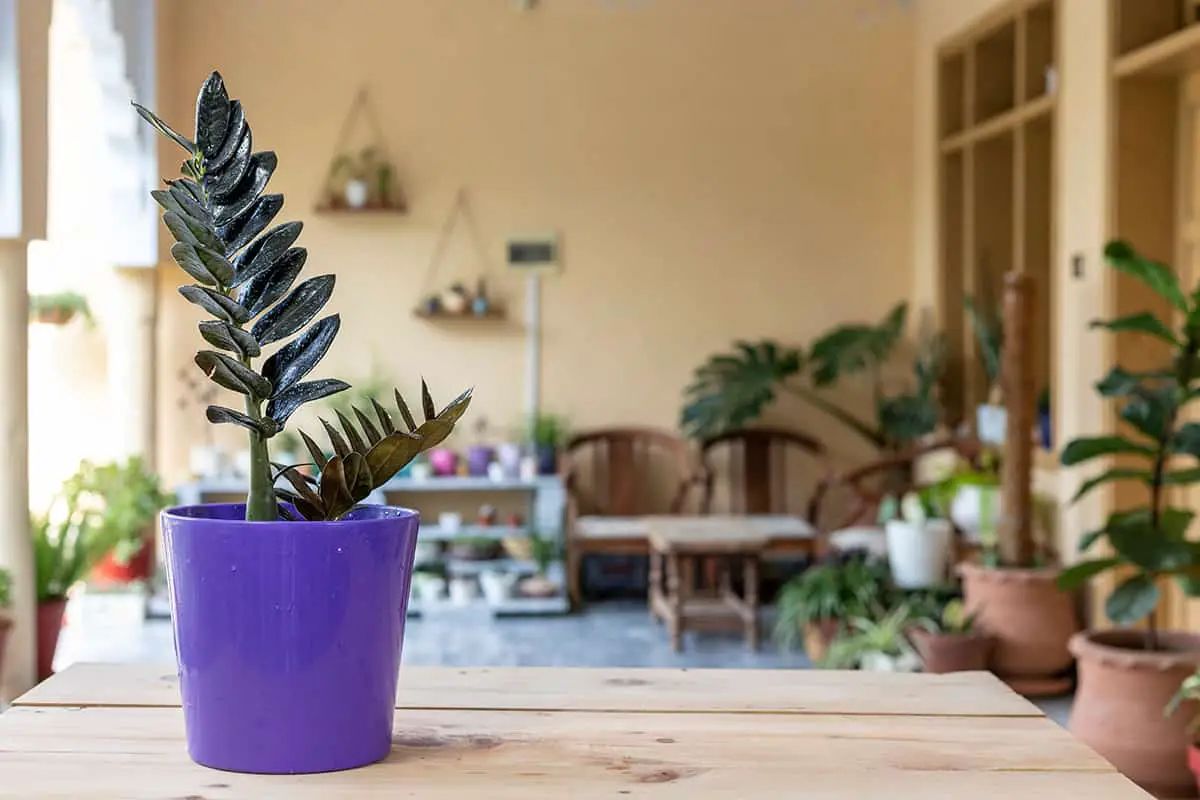Adding a touch of sophistication to your home decor can be as simple as incorporating black houseplants, like the striking Black Velvet Alocasia. Its lush, dark leaves bring an unexpected elegance to any room, proving that plants don’t just come in shades of green.
In this article, we’ll introduce you to 15 black houseplants that are sure to make a bold statement in your living space, blending perfectly with any style or palette.
Table of Contents
- Black Coral Snake Plant
- Raven ZZ Plant
- Black Velvet Alocasia
- Black Magic Colocasia
- Burgundy Rubber Plant
- Black Prince Echeveria
- Aeonium ‘Zwartkop’
- Purple Knight Alternanthera
- Black Pagoda Lipstick Plant
- Philodendron ‘Black Cardinal’
- Darth Vader Begonia
- Schismatoglottis ‘Moonlight’
- Peperomia Caperata ‘Raven’
- Black Hoya
- Pilea Peperomioides ‘Chinese Money Plant’
Black Coral Snake Plant
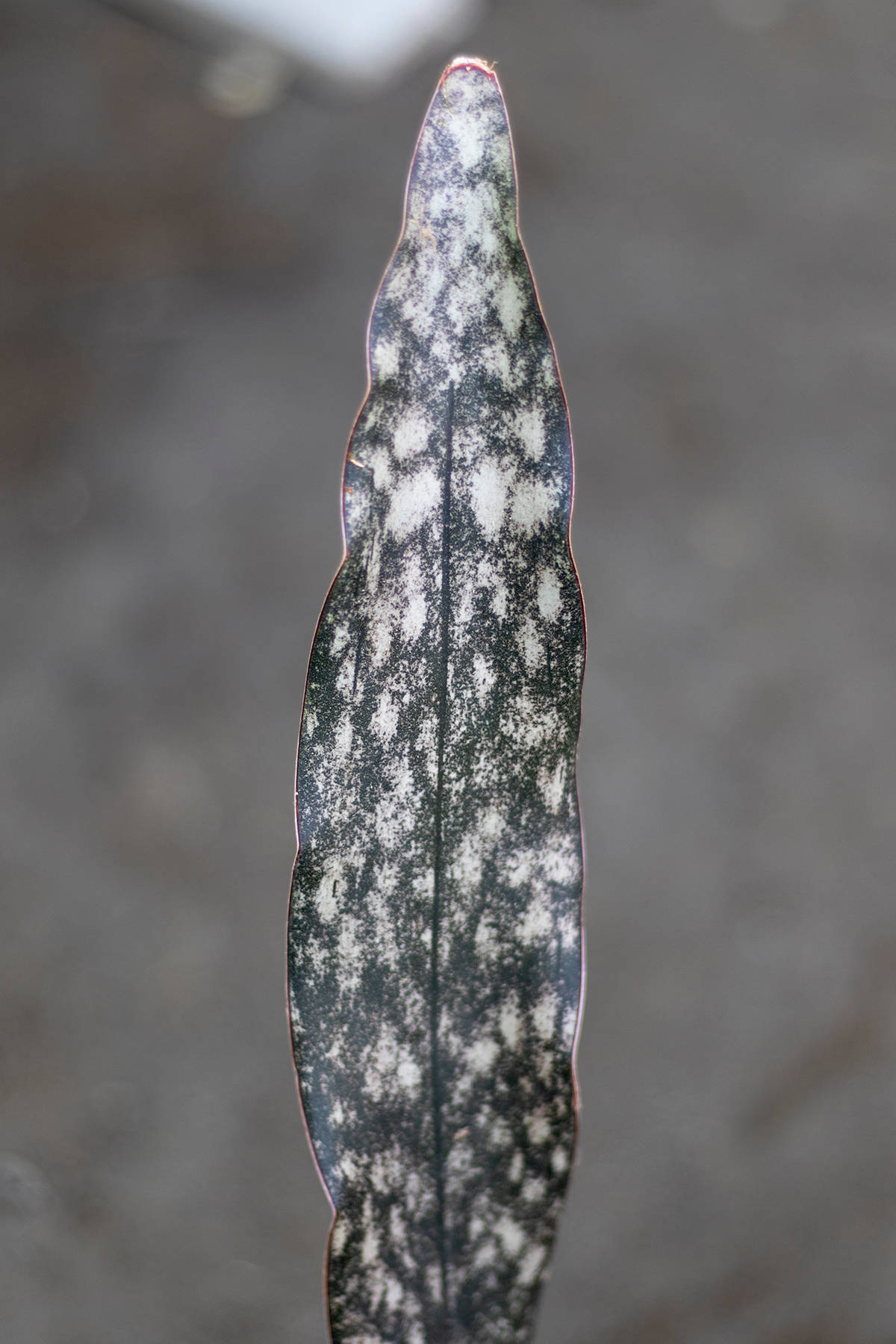
Are you looking for a stunning houseplant with a dark appearance? Meet the Black Coral Snake Plant. This low-maintenance plant belongs to the genus Dracaena and adds a touch of sophistication to your indoor space. Its uniquely dark foliage sets it apart from other houseplants.
The Black Coral variety boasts dark green leaves with striking light green horizontal bands. As it matures, the plant’s leaves grow tall and upright, resembling a sword or spear. You’ll love the architectural element this plant brings to your home decor.
Maintaining your Black Coral Snake Plant is simple. Place it in a well-draining pot and position it in an area with low to bright indirect light. Avoid overwatering, as it prefers to dry out slightly between waterings. This hardy houseplant tolerates various conditions, making it perfect for beginners.
Frequent repotting is unnecessary due to the slow growth rate of your Black Coral Snake Plant. But when repotting is required, use a pot slightly larger than the previous one. This ensures its optimal growth and prevents root rot. Besides being an aesthetic addition, this plant is also known for its air purifying qualities, as it removes toxins such as benzene, formaldehyde, and trichloroethylene from the air.
Raven ZZ Plant
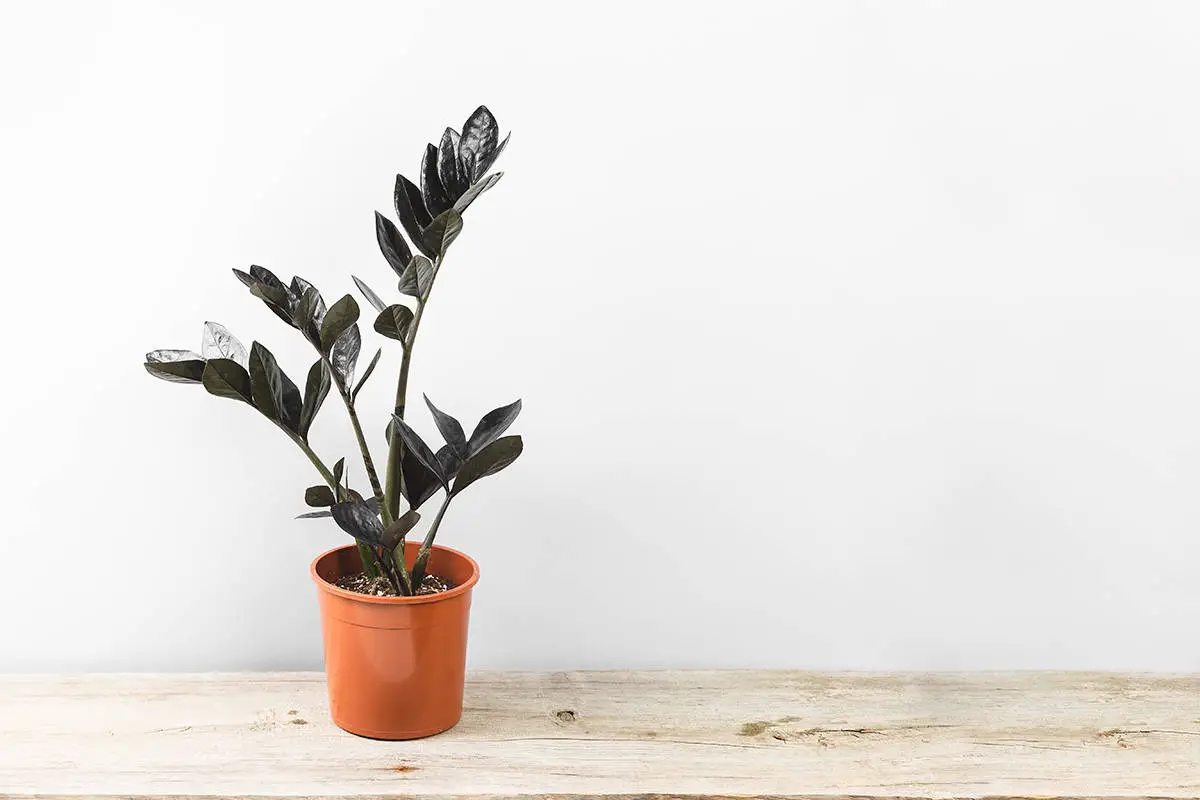
The Raven ZZ Plant is a tropical succulent with eye-catching dark-colored foliage. As a houseplant, you will appreciate its low-maintenance nature and slow growth rate, which eventually reaches up to 3 feet in height and width.
In your home, the Raven ZZ Plant thrives in partial to deep shade, making it suitable for rooms without direct sunlight. It is essential to provide this plant with good drainage, as overwatering can damage its roots.
Apart from its stunning appearance, the Raven ZZ Plant is highly resilient. You can expect it to withstand various conditions, including low light and infrequent watering. This hardiness allows you to place it in greenery displays or larger arrangements without fear of it suffering from adverse conditions.
Black Velvet Alocasia
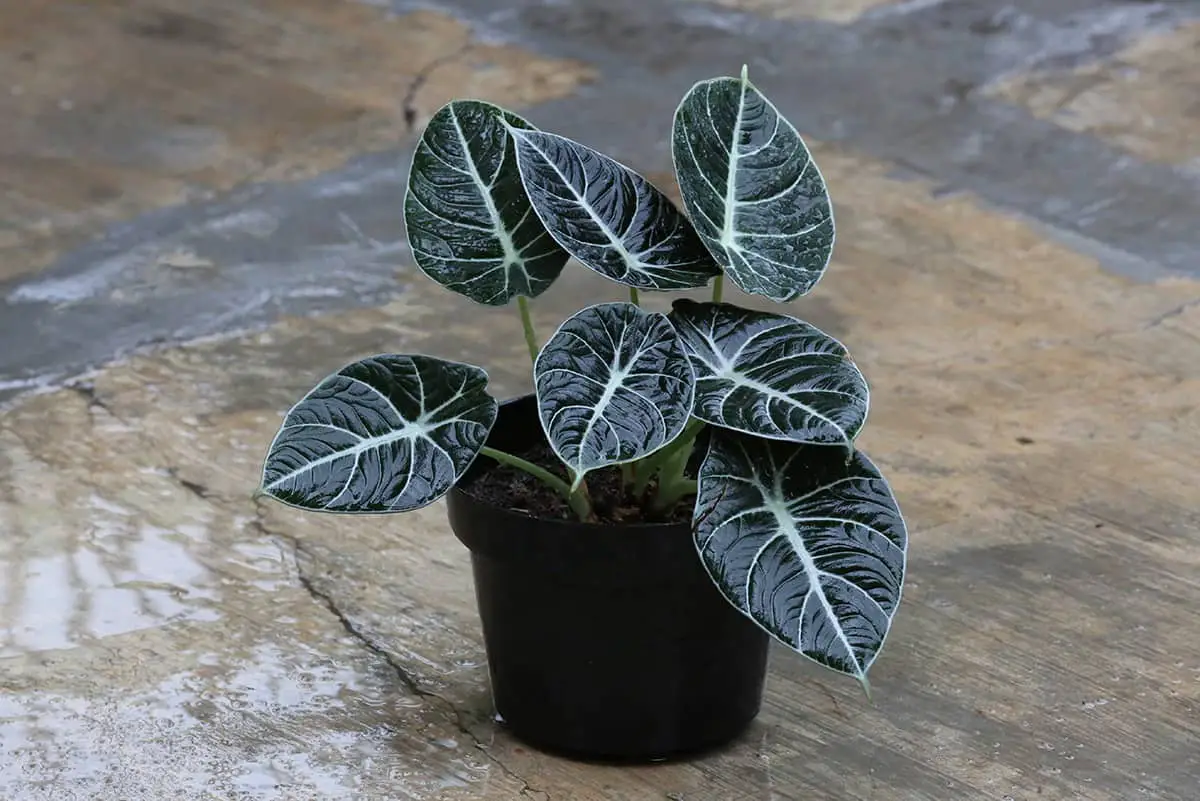
Looking to add a unique touch to your indoor plant collection? The Black Velvet Alocasia is a perfect choice. This stunning houseplant has velvety black leaves with platinum-colored veins, giving it the nickname “black velvet.” It is a compact plant, typically growing less than a foot high and up to 18 inches wide.
To take care of your Black Velvet Alocasia, consider its tropical origin. It thrives in environments with high humidity and well-drained, humus-rich soil. The plant prefers temperatures ranging from 68 to 77 degrees Fahrenheit, but it is not frost-tolerant. So, ensure that you place it indoors in a shaded area during colder months.
Proper watering is essential for the health of your Black Velvet Alocasia. It’s crucial to provide enough moisture without overwatering, as this may cause root rot. You should also keep in mind that elephant ears like Alocasia require fertilizer and plenty of water to grow healthily. You can achieve an ideal watering balance by allowing the soil to dry slightly between waterings.
Black Magic Colocasia
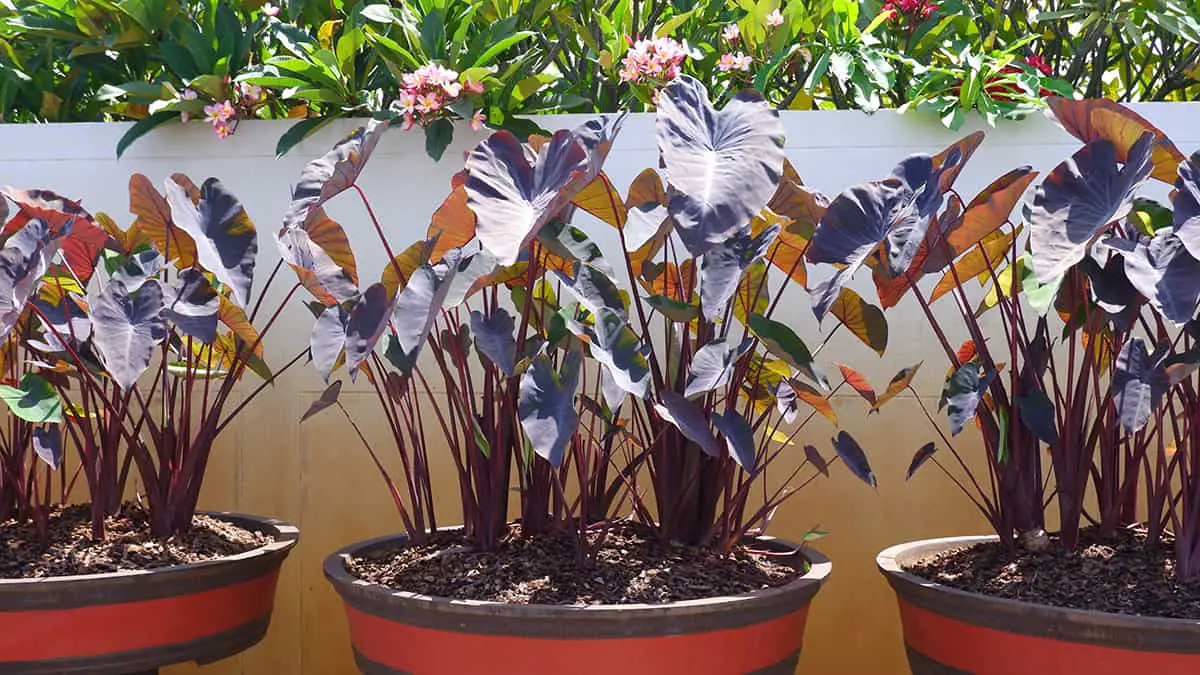
The Black Magic Colocasia adds a touch of mystery to your home with its stunning dark foliage. A tropical plant native to Southeastern Asia, its large leaves are heart-shaped, and the color ranges from deep purple to nearly black.
Your Black Magic Colocasia not only beautifies your home but is also easy to care for with the right environment. They thrive in well-draining, fertile soil with a pH of 5.5 to 6.5. You should keep the plant in a warm, humid area with indirect sunlight to prevent scorched leaves. They demand constant moisture, so regularly watering them is essential. When properly cared for, your plant will reward you with dramatic, lush foliage.
To propagate your Black Magic Colocasia, you can use its vegetative methods which include dividing the corms.
Burgundy Rubber Plant
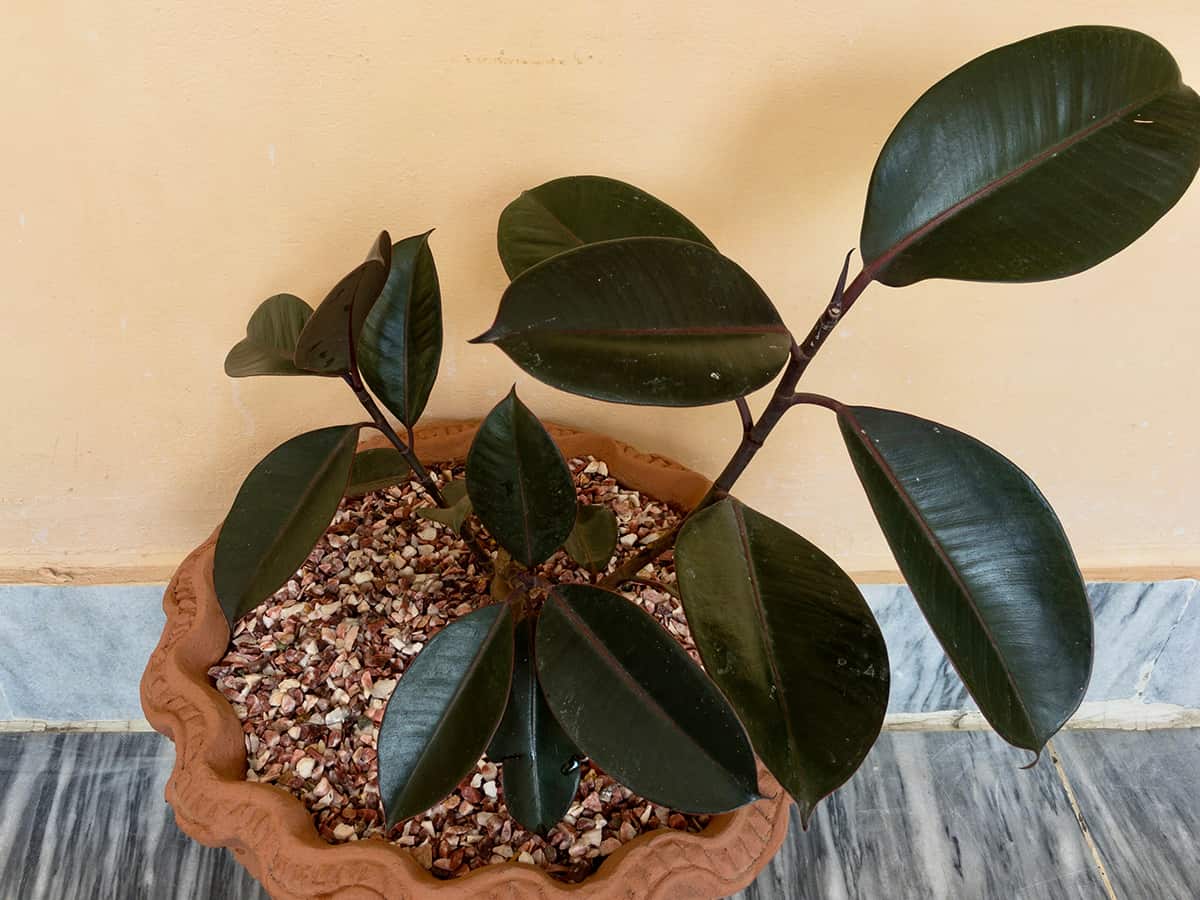
The Burgundy Rubber Plant is a stunning addition to your collection of black houseplants. This plant is a type of Ficus elastica, known for its glossy maroon-black foliage. Your home will feel more lush and sophisticated with this stylish plant.
Caring for this plant is quite simple. It thrives in bright indirect light, so keep it near a well-lit window. Make sure to protect it from direct sunlight, as that may cause leaf burn. The plant is accustomed to average room temperatures between 60 to 65 °F at night and 75 to 80 °F during the day, so maintain a consistent environment for it without cold drafts or sudden temperature drops.
Watering needs are moderate – whenever the top inch of soil feels dry to the touch, it’s time to water thoroughly. Ensuring your plant sits in well-draining soil is also important to prevent root rot. Lastly, regular dusting keeps the leaves shiny and the plant healthy.
Black Prince Echeveria
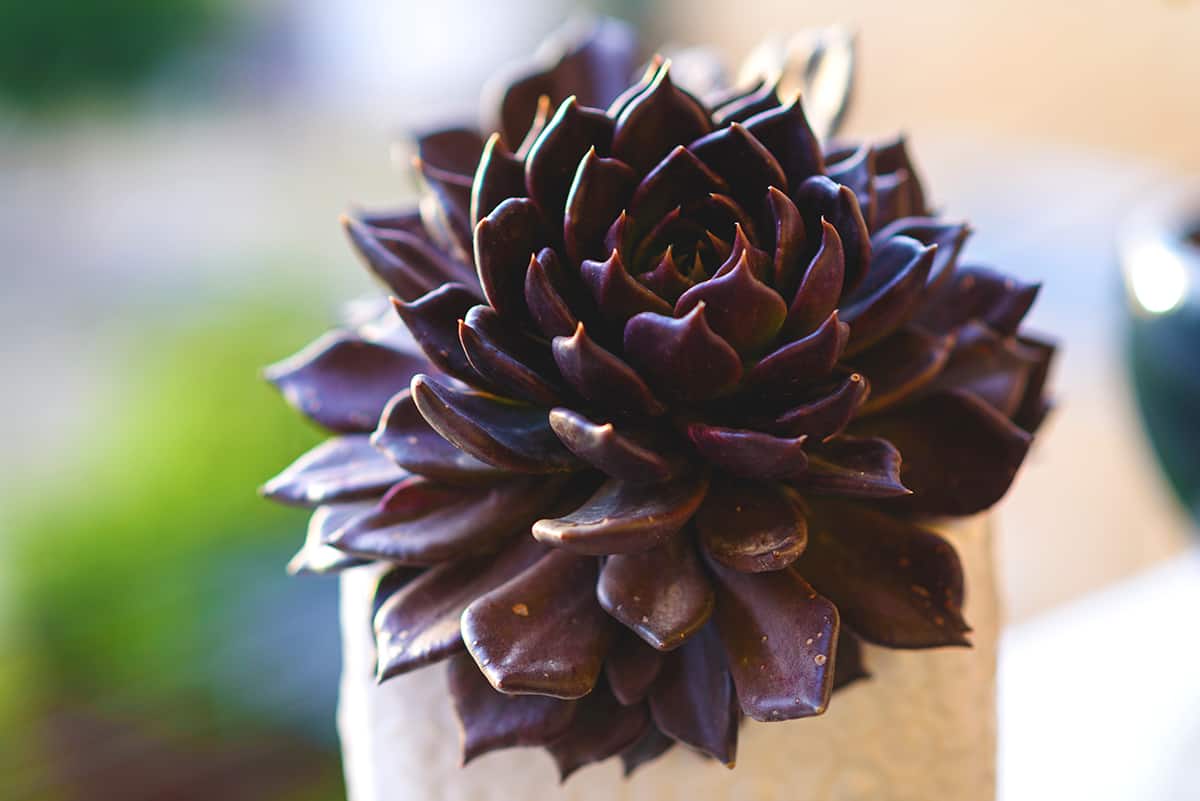
The Black Prince Echeveria is a popular choice among dark-leaved houseplants. Known for its striking, almost black leaves, this plant resembles a water lily flower in shape. You can expect the leaves of your Black Prince to have a dark red tint, giving the plant its unique and mysterious appearance.
As a succulent, this plant requires minimal care and is quite resilient. Make sure to provide adequate sunlight, as it thrives in bright conditions; however, avoid direct sun exposure as it can harm the leaves. Water the plant sparingly, allowing the soil to dry out between watering sessions. Overwatering can lead to root rot, a common issue with succulents.
Cultivating your Black Prince Echeveria is not very difficult. Propagation can be done through leaf cuttings or by dividing the offsets that develop around the mother plant. Moreover, this stunning plant can be combined with other succulents to create visually striking arrangements indoors.
Aeonium ‘Zwartkop’
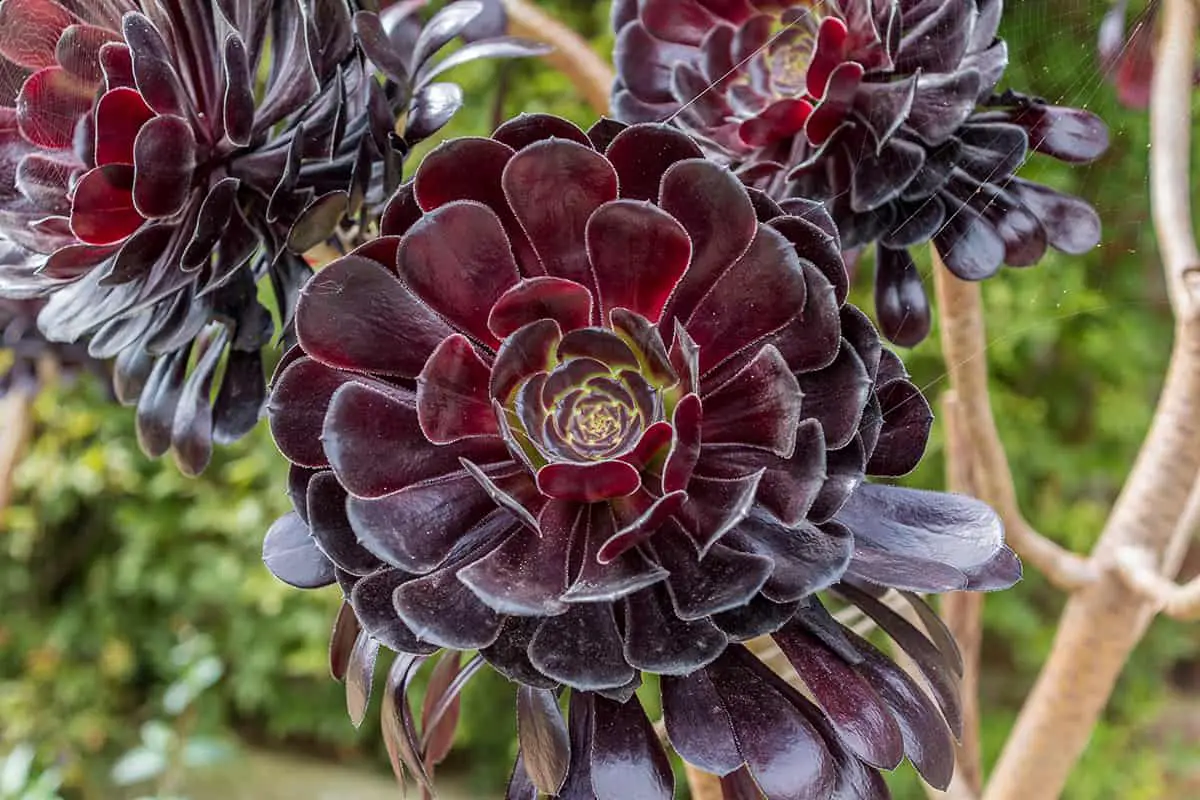
Aeonium ‘Zwartkop’ is a stunning black houseplant that you can include in your collection. Also known as Aeonium arboreum ‘Zwartkop’, this succulent has dark foliage that adds a mysterious touch to your indoor garden.
Originating from the Canary Islands, Cape Verde Islands, Madeira, and parts of Northern Africa, Aeoniums thrive in mild, dry climates. With their colorful rosettes of thick, waxy leaves, they are not only distinctive but also low-maintenance.
The ‘Zwartkop’ variety has glossy leaves that are so dark purple they appear black. This striking color remains consistent throughout the winter months, as mentioned by Wisconsin Horticulture. In the right environment, these lovely plants can grow both robust and tall.
To ensure your Aeonium ‘Zwartkop’ stays healthy, provide ample sunlight and well-draining soil. As a succulent, it requires minimal watering but will appreciate a bit more water during its active growth period. Avoid overwatering, as this can lead to root rot and other issues.
Purple Knight Alternanthera
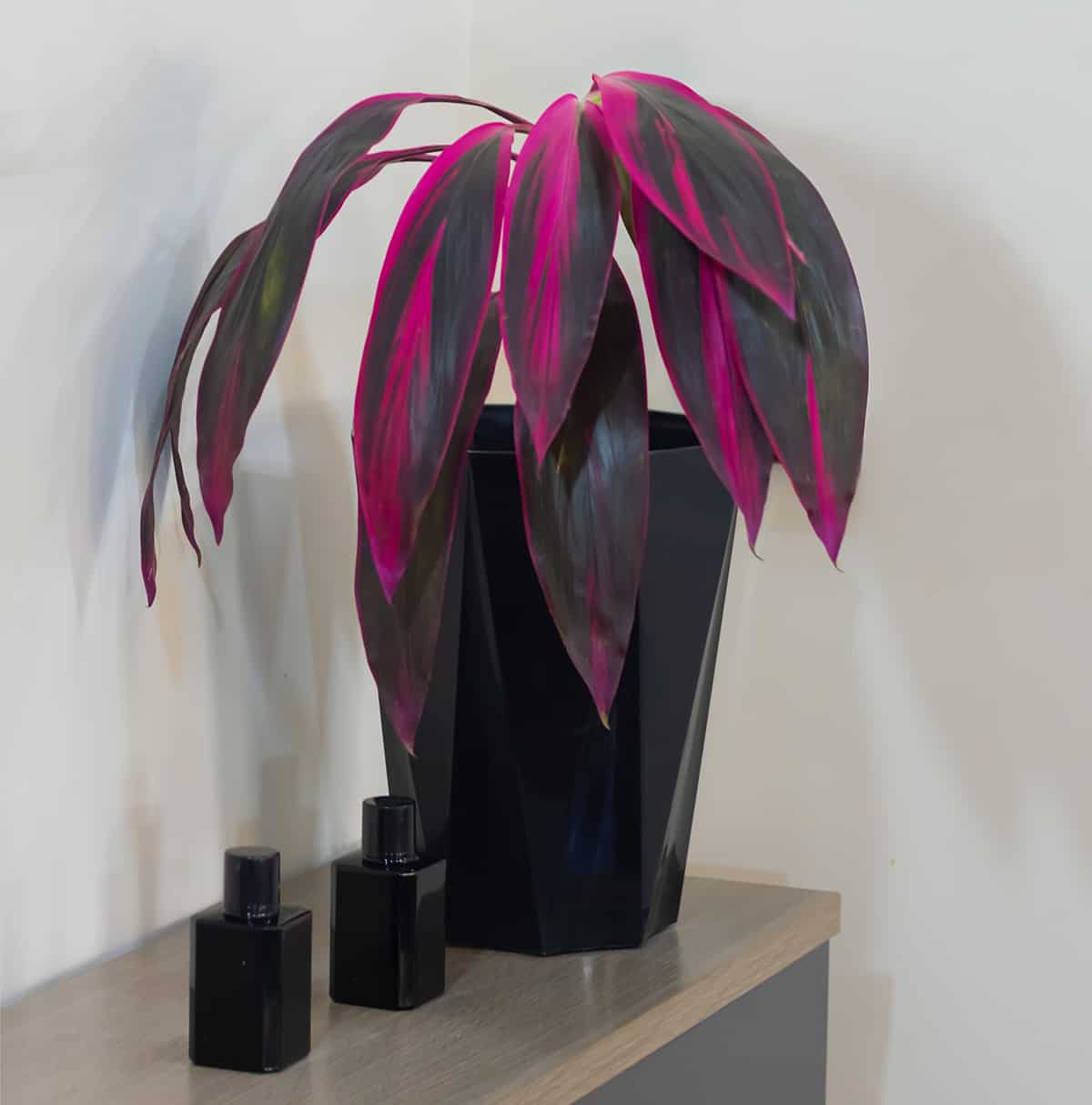
You may be looking for a unique and eye-catching black houseplant to add to your collection. Meet the Purple Knight Alternanthera, an evergreen perennial that makes a dramatic statement. This plant is known for its striking dark purple foliage and can grow up to 36 inches tall, making it a prime choice for creating an accent and contrast in your home.
The Purple Knight prefers full-sun to lightly shaded locations, which helps it maintain its rich and vibrant color. Make sure to place this plant in a spot with plenty of bright light, as it showcases the best color when exposed to sunlight. Moreover, it grows well in rich soil and consistent moisture, which ensures healthy growth and a stunning display.
Another important aspect that makes Purple Knight a great addition to your garden is its drought tolerance. Although you should water the plant regularly, it can withstand both drenching rains and hot periods of drought. This adaptability makes it an ideal choice if you’re looking for a low-maintenance black houseplant that flourishes in various conditions.
Black Pagoda Lipstick Plant
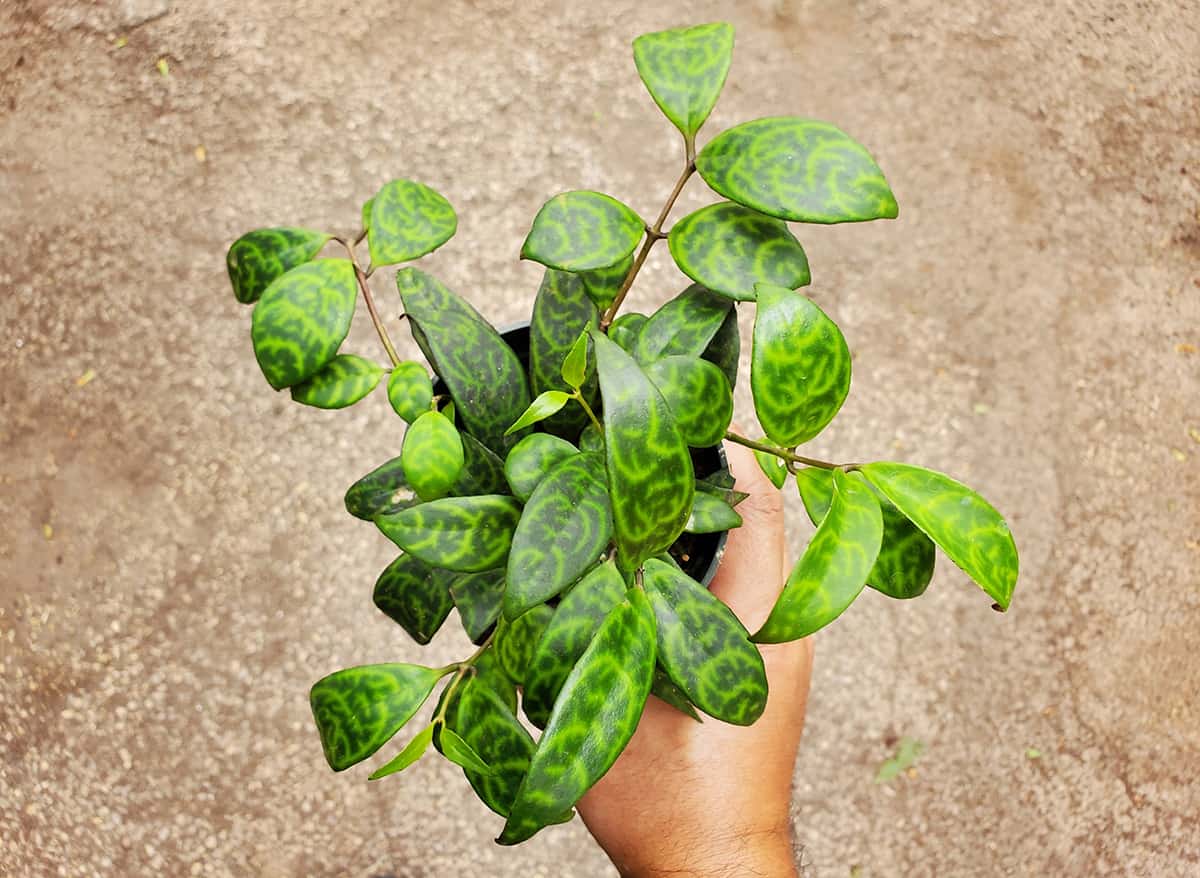
With its vine-like habit and mottled foliage, Black Pagoda Lipstick Plant is a beautiful addition to your houseplant collection. This epiphytic plant, Aeschynanthus radicans ‘Black Pagoda’, features leathery, ovate to lanceolate leaves that are often opposite or whorled.
To care for your Black Pagoda Lipstick Plant, provide it with bright, indirect light. Too little light can cause the foliage to lose its distinctive pattern. Keep the environment humid and maintain a temperature between 50 and 80°F. Avoid temperatures below 50°F, as it can cause leaf drop. When watering your plant, use a well-draining potting mix and allow the soil to dry slightly between waterings. Overwatering can lead to root rot and damage the plant’s health.
Propagation of the Black Pagoda Lipstick Plant is achievable through stem tip cuttings. Allow the cutting to dry for a few hours before placing it in a moist potting mix. Keep the humidity high and maintain a temperature of around 70°F to encourage rooting.
Philodendron ‘Black Cardinal’
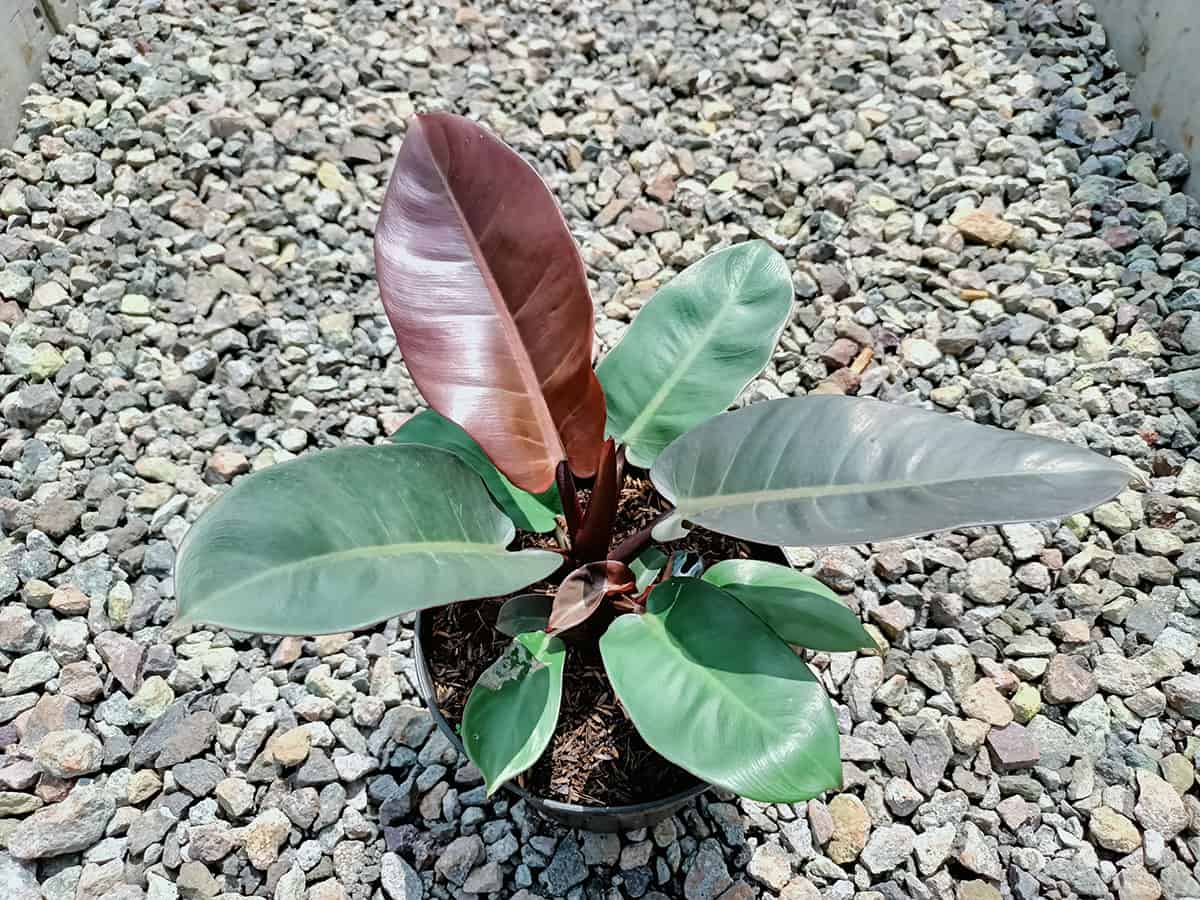
With its large, heart-shaped leaves that start bright burgundy and darken to almost black, the Philodendron ‘Black Cardinal’ is a showstopper. The leaves can reach 8 to 10 inches long and have prominent petioles with red stems. This self-heading Philodendron thrives in low light conditions, making it ideal for your home or office.
Caring for your Philodendron ‘Black Cardinal’ is relatively simple. Provide it with well-draining soil and water when the top inch of the soil feels dry. Avoid overwatering, as this can lead to root rot. Keep it in a location with indirect sunlight and maintain a consistent temperature above 65°F.
Your Philodendron may produce some aerial roots, which are natural support structures that help it climb in its native habitat. Don’t worry about them, as they contribute to the plant’s unique appearance. If you prefer, you can let them grow as-is or attach them to a support structure like a trellis or moss pole.
Pests are not a common issue with the Philodendron ‘Black Cardinal’, but you should still check for potential infestations such as spider mites, aphids, or mealybugs. Keep an eye for any signs of infection, and address them promptly to maintain your plant’s health.
Darth Vader Begonia
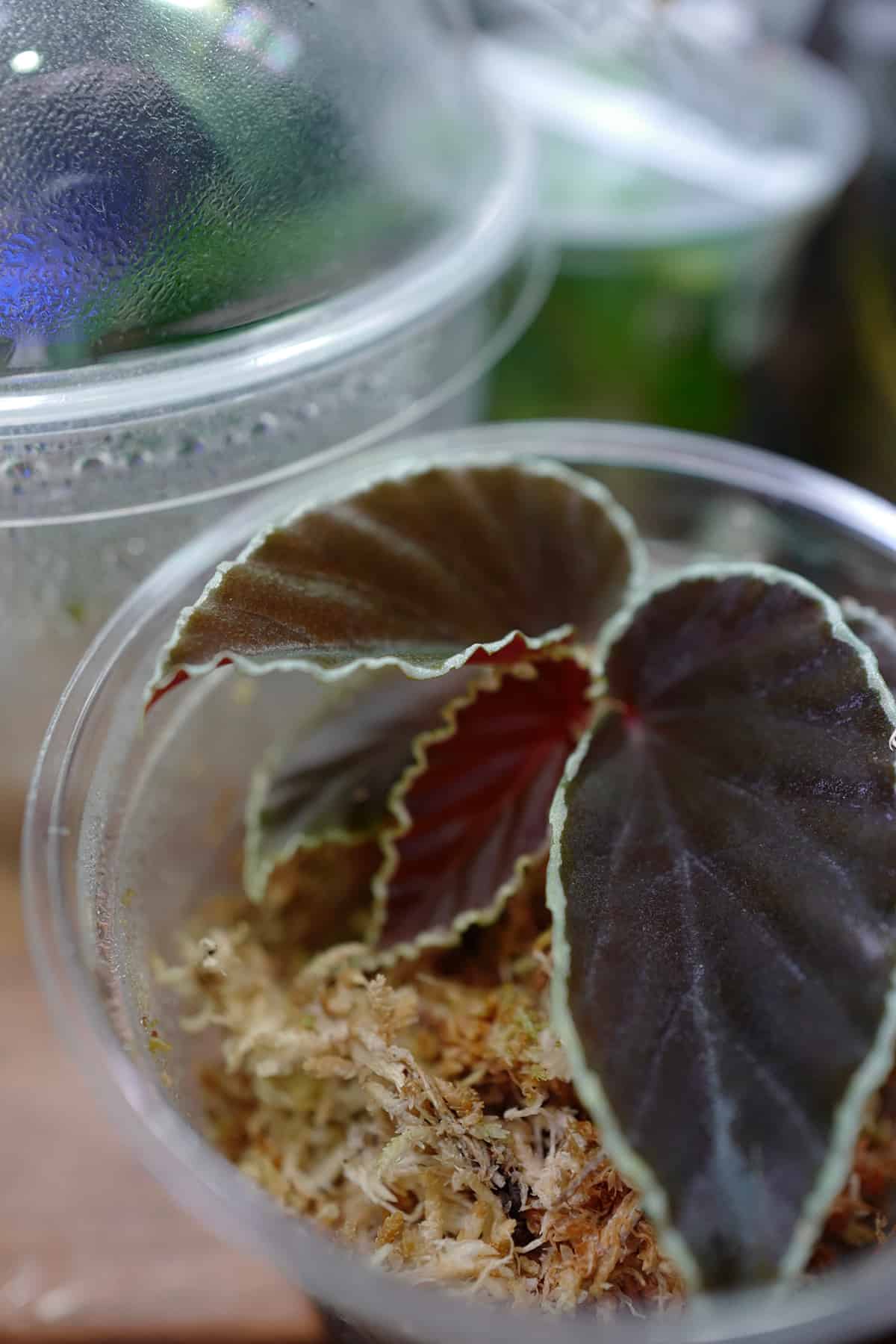
This black houseplant gets its name from the famous Star Wars character because of its dark leaves and mysterious appearance. It’s a type of begonia that belongs to the large begonia family, which contains over 1,800 species and hybrids.
To care for your Darth Vader Begonia, keep it in a brightly lit space with some direct sunlight. This plant will appreciate well-draining soil and a pot with drainage holes. Water when the top inch of soil feels dry to touch, but make sure not to over-water or let it sit in water.
Your Darth Vader Begonia will benefit from regular fertilizing during its growing season. Use a balanced, water-soluble fertilizer diluted to half-strength every four weeks. Since this is a tropical plant, it’s also important to maintain indoor humidity above 50%. Place its pot on a tray of wet pebbles or use a humidifier to help achieve the desired humidity.
Schismatoglottis ‘Moonlight’
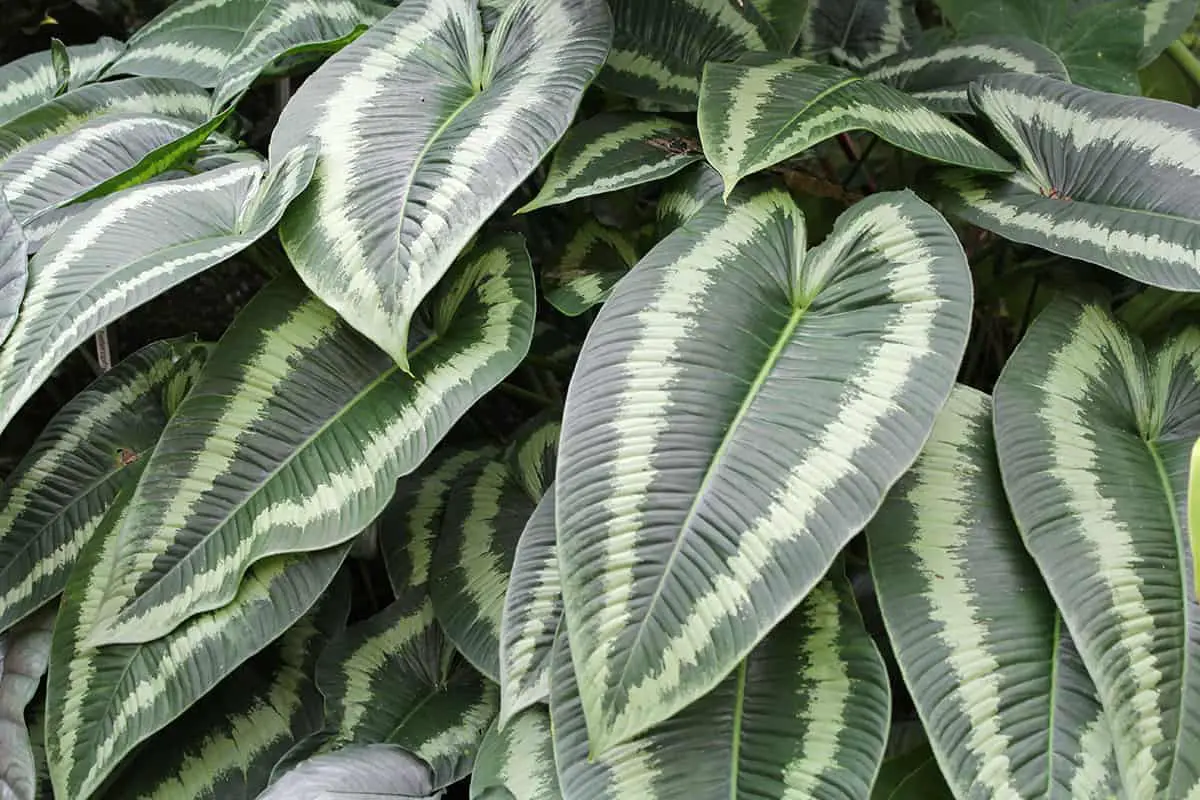
If you’re looking for a unique addition to your collection of black houseplants, consider the Schismatoglottis ‘Moonlight’. Its dark foliage creates a mesmerizing contrast with the lighter surroundings. Let’s dive into the details of this stunning plant.
Schismatoglottis ‘Moonlight’ is a member of the Araceae family. It’s aesthetically attractive and, at the same time, easy to care for. This plant is known for its dark green leaves with silvery-grey veins. The color deepens with age, creating a sophisticated black appearance.
When it comes to caring for the Schismatoglottis ‘Moonlight’, you’ll find it quite manageable. It prefers indirect sunlight and thrives in a well-draining potting mix. Maintain a consistent moisture level in the soil, but avoid overwatering.
To ensure the health of your Schismatoglottis ‘Moonlight’, monitor its growth. Regularly inspect the leaves for signs of pests or disease. Pruning older leaves encourages new growth, making your plant even more appealing to the eye.
Peperomia Caperata ‘Raven’
Peperomia Caperata ‘Raven’ is a unique, black-foliaged plant perfect for adding contrast to your collection of houseplants. It belongs to the Piperaceae family, which includes over 1,000 species of peperomia plants.
This tropical, evergreen plant is native to South America and known for its striking, dark leaves. The rippled texture and the stunning deep purple, almost black color of the Raven’s leaves will make it stand out in any corner of your home. To keep it healthy, provide it with bright, indirect light.
Consider placing your Peperomia Caperata ‘Raven’ in a well-draining potting mix, as these plants prefer a more humid environment. Be careful not to overwater, as it can lead to root rot. Water it only when the soil feels dry to the touch.
As a compact plant with a maximum height of 8 inches, the ‘Raven’ is an excellent choice for small spaces.
Black Hoya
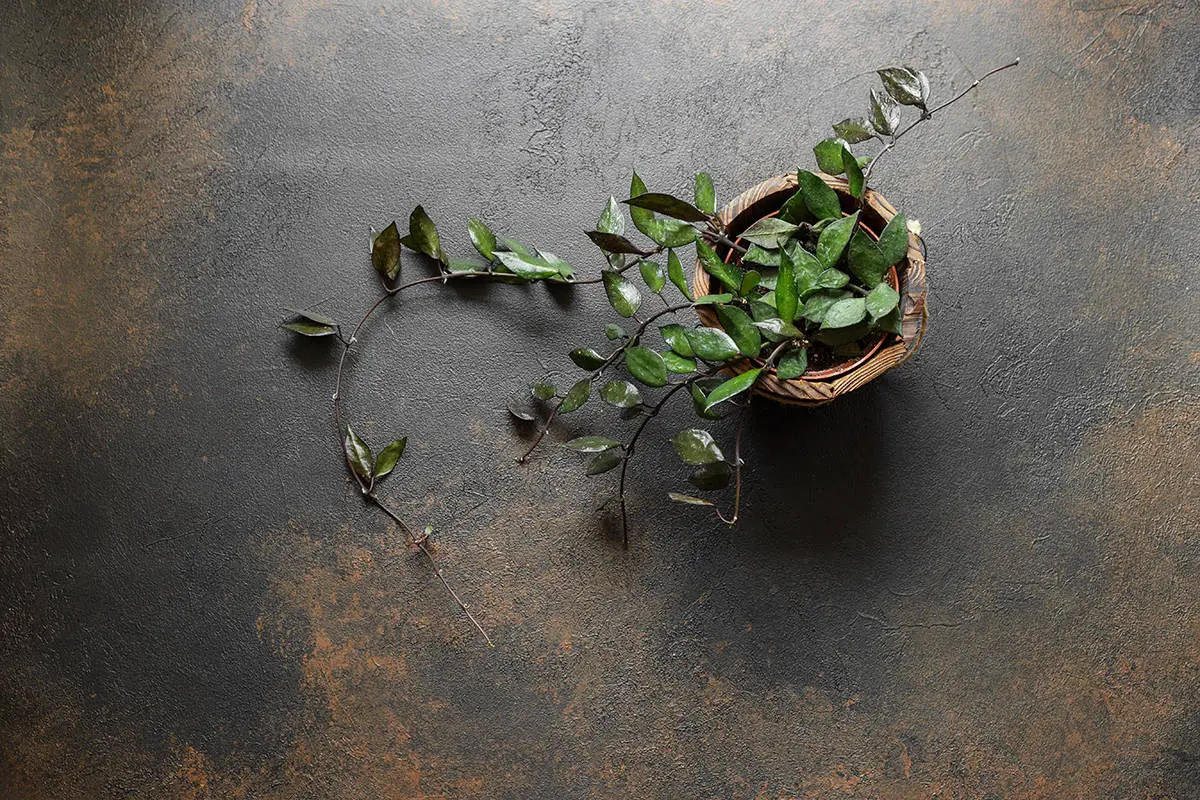
Known for its dark foliage and unique look, The Black Hoya adds a touch of elegance and drama to any space.
When it comes to growing a healthy Black Hoya, you should provide it with bright indirect sunlight. Too much direct sunlight can cause the leaves to fade and lose their dark color. On the other hand, low light conditions will prevent the attractive foliage from showing its true colors. So, make sure to find a spot with just the right amount of light.
Proper watering is essential for a thriving Black Hoya. It’s crucial not to overwater this plant, as it may lead to root rot. Allow the soil to dry out slightly between waterings. You can then water the plant thoroughly until water drains out of the bottom of the pot. It’s also important to use well-draining soil to prevent waterlogged conditions.
One distinctive feature of the Black Hoya is its fragrant, star-shaped flowers. These blooms often appear in clusters and emit a pleasant scent. However, keep in mind that it may take 2 to 3 years for your plant to flower. Patience is key, and the beautiful blossoms will be worth the wait!
Pilea Peperomioides ‘Chinese Money Plant’
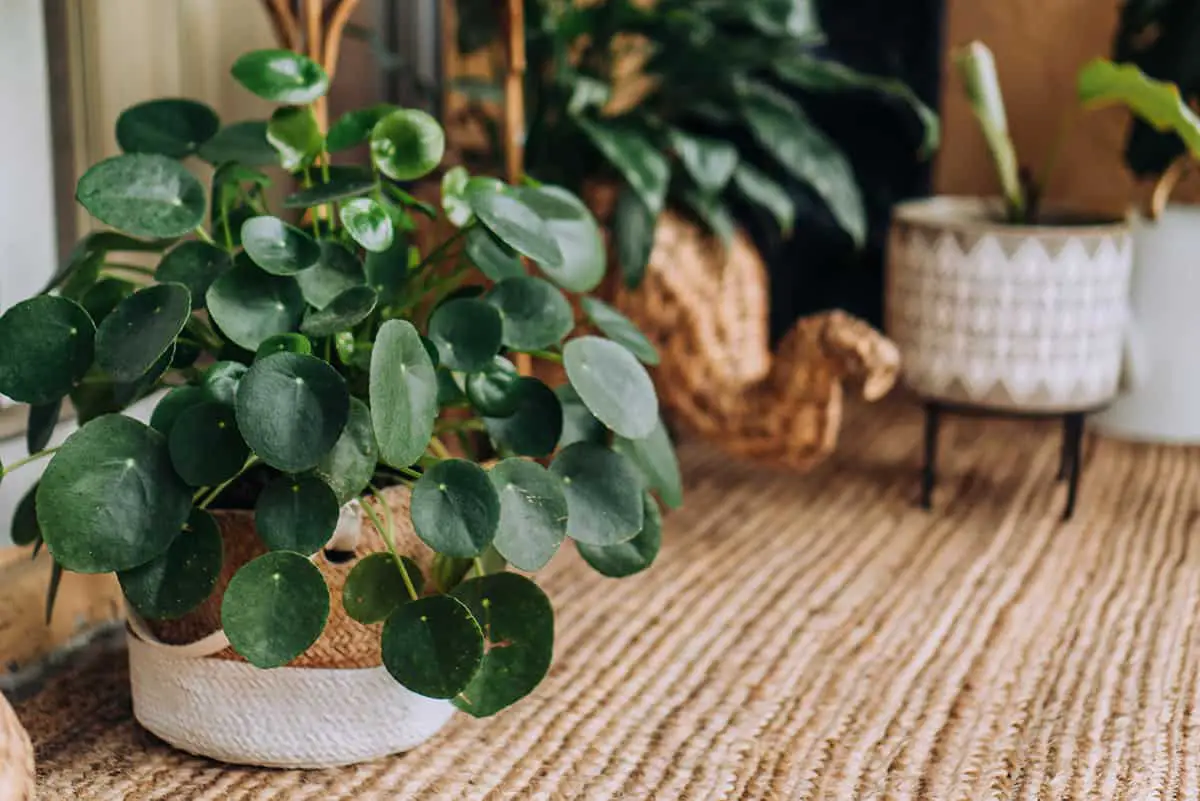
You might be fascinated by the Chinese Money Plant or Pilea peperomioides. This plant adds a touch of uniqueness to your black houseplant collection. It’s known for its round, coin-like leaves, which give it an interesting appearance.
When choosing a spot for your Chinese Money Plant, ensure it receives bright, indirect sunlight. Direct sunlight may cause the leaves to scorch, while low light can lead to poor growth. Maintain an indoor temperature range between 60-75°F for the best results.
Watering your Pilea is an essential step, as it prefers a moist but well-draining soil. Be careful not to overwater, as this can cause root rot. Let the soil dry slightly between waterings. A well-balanced fertilizer with a 3-1-2 ratio can be applied once a month to encourage healthy growth.
Another key aspect of caring for your Pilea is its humidity. Most houseplants, including this one, thrive in a moderately humid environment. To maintain optimal humidity, try placing the plant on a tray filled with pebbles and water or use a humidifier.
